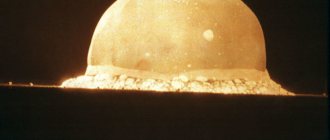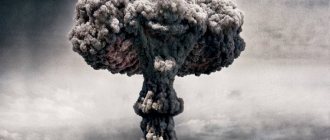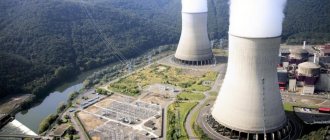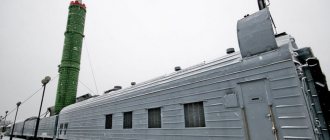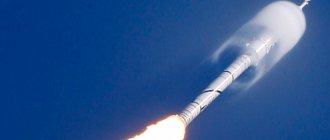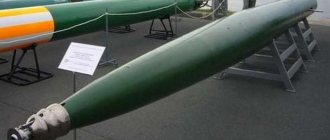In our time, scientists and military personnel have been able to create weapons that are several times more powerful than those that were used by America in 1945 to bomb the cities of Hiroshima and Nagasaki in Japan. After that incident, many states in the world began to develop the production of nuclear weapons and stockpile them in large quantities.
Photo: eng.mil.ru
Modern realities are such that the presence of nuclear weapons has become an integral part of security for many countries of the world. The nuclear bombs currently being produced are thousands of times more powerful than those that destroyed Japanese cities. Since then, the arms race of various countries began and to this day it does not stop.
We present the rating of 10 states with the most powerful nuclear potential in the world. They can rightfully be called superpowers. When compiling the list, experts took into account the number of nuclear warheads owned by countries. Data provided by the Arms Control Association.
| Rating | Number of nuclear warheads |
| 1. Russia | 6375 |
| 2. USA | 5800 |
| 3. China | 320 |
| 4. France | 290 |
| 5. UK | 215 |
| 6. Pakistan | 160 |
| 7. India | 150 |
| 8. Israel | 90 |
| 9. North Korea | 30-40 |
| — Iran | no exact data |
Types of nuclear weapons
All nuclear weapons available on the globe can be divided into two types:
- Atomic weapons are single-phase type explosive mechanisms. During the fission of heavy nuclei of plutonium or uranium 235, energy is released;
- Thermonuclear weapon is an explosive mechanism with a two-phase type. During the impact of the first phase, the release of energy occurs due to the fission of heavy nuclei. During the operation of the second phase, a phase with thermonuclear fusion is connected to fission reactions. In the process of proportional composition of reactions, the types of these weapons are determined.
From the history of the emergence of nuclear weapons
In 1889, the Curie couple made a grand discovery in the scientific world. They discovered a hitherto unknown substance in a piece of uranium that released a colossal amount of energy.
After this discovery, events developed as follows. E. Rutherford studied the basic properties of atoms. E. Walton and D. Cockroft were the first in the world to carry out the splitting of the atomic nucleus. And already in 1934, scientist Leo Szilard registered a patent for the creation of an atomic bomb.
The purpose for which atomic weapons were created is very trivial - world domination, with the intimidation and destruction of one’s enemies. Thus, when World War II was already underway, scientists in Germany, the Soviet Union and the United States were engaged in scientific research and development of nuclear weapons. These three largest and most powerful states, actively participating in hostilities, attempted to achieve victory at any cost. Moreover, if at that time they had managed to use these weapons as a key factor in victory, then they could have been used more than once in other military conflicts.
Nuclear powers of the world for 2022
The states that currently possess nuclear weapons are secretly called the Nuclear Club.
The following are considered legitimate within the international legal framework:
- United States of America (USA);
- Russia (which received nuclear weapons from the USSR after its collapse);
- France;
- Great Britain;
- China.
The following are considered illegitimate:
- India;
- North Korea;
- Pakistan.
There is another state - Israel. Officially, it does not have its own nuclear weapons. However, the world community is of the opinion that Israel should take its place in the Nuclear Club.
However, it is possible that there may be other participants on this list. Many world states had nuclear programs, but some of them gave up the idea later, and some are still working on them to this day. In some states, such weapons are supplied by other countries, for example, the United States. The exact number of weapons and how many nuclear powers own these weapons in the world is not known. However, approximately twenty and a half thousand nuclear warheads are scattered throughout the globe.
In 1968, they signed the Treaty on the Non-Proliferation of Nuclear Weapons. Later in 1986 they signed the Nuclear Test Ban Treaty. However, not all states decided to sign and ratify (legalize) these documents. Thus, the threat to the world is still real. Moreover, no matter how strange it may sound, at present the presence of nuclear weapons is a guarantee of peace, a deterrent that can protect against aggression, which is why many states are so eager to acquire them.
Pakistan
Number of nuclear warheads: 130-140 First test: 1998 Last test: 1998
It is not surprising that India and Pakistan, having a common border and being in a state of permanent hostility, are trying to overcome and overcome their neighbors, including in the nuclear sphere. After the Indian explosion of 1974, it was only a matter of time before Islamabad developed. As the then Prime Minister of Pakistan said: “If India makes its own nuclear weapons, we will make ours, even if we have to eat grass.” However, they did this twenty years late.
INTERESTING TOP 10 Most Beautiful Japanese Girls
After India conducted tests in 1998, Pakistan quickly conducted its own, detonating several nuclear bombs at the Chagai test site.
United States Arsenal
Today, the United States has an arsenal of 1,654 warheads. The United States is armed with bombs, warheads, and shells. All this is used in military aviation, the submarine fleet, and also in artillery.
At the end of World War II, the United States produced over sixty-six thousand bombs with warheads, but already in 1997 the production of new types of nuclear weapons was completely stopped. By 2010, the United States arsenal consisted of more than five thousand nuclear weapons. Since 2013, their number has decreased to 1,654 units according to the project, which involved a reduction in nuclear potential.
As the unofficial world leader, the United States has the status of a nuclear power and, according to the 1968 treaty, as part of five states, it legitimately possesses nuclear weapons.
Russia (former USSR) is the second nuclear power
Russia currently has 1,480 warheads and 367 nuclear delivery vehicles. This ammunition is intended for use by missile forces, naval strategic forces and strategic aviation. Over the past decade, Russia's operational nuclear stockpile has decreased significantly, by 12% per year. Due to the signing of an agreement on mutual disarmament, by 2012 it was supposed to decrease by 2/3.
Today, the Russian Federation, as the successor to the USSR, is one of the main members of the 1968 agreements on nuclear weapons and possesses them legally. In the current global political and economic situation, Russia is being opposed to the United States and European countries. However, with such a serious arsenal, you can defend your independent positions on geopolitical issues.
Russian Federation
- Status: official.
- First test: 1949.
- Last test: 1990.
- Arsenal size: 2,825 units.
- Test Ban Treaty (CTBT): Ratified.
The Soviet Union was the second country to detonate a nuclear bomb (1949). From then until 1990, Russia carried out at least 715 nuclear tests involving testing of 970 different devices. Russia is one of the most powerful nuclear powers in the world. The first nuclear explosion, with a yield of 22 kilotons, received its own name “Joe-1”.
The Tsar Bomba is by far the heaviest atomic weapon of all time. It was tested in 1967, detonating at a whopping 57,000 kilotons. This charge was originally designed at 100,000 kilotons, but was reduced to 57,000 kilotons due to the high likelihood of excessive radioactive fallout.
British nuclear capability
The UK has 225 nuclear warheads. Of these, over 160 are in combat readiness and are located on submarines. No one has accurate information about the weapons of the British army. They do not disclose the exact size of their nuclear arsenal. The UK has no desire to increase its nuclear stockpile, nor to reduce it. It is guided by a policy of deterring allied and neutral states from using these weapons.
Chinese nuclear potential
According to American experts, the Chinese have approximately 240 warheads. Although according to official data, the Chinese military has approximately 40 intercontinental missiles, which are controlled by artillery and submariners. In addition, the Chinese army has approximately 1,000 short-range missiles.
Chinese authorities do not disclose precise information about their arsenal. They state that their nuclear weapons are expected to be maintained at the lowest level that is safe. Moreover, the Chinese authorities say that they will not be the first to use nuclear weapons, and in relation to non-nuclear states they will not use them at all. Such statements are only welcomed by the international community.
Statistics[ | ]
| a country | number of warheads (active/total)[19] | date of first test | testing area |
| "Old" nuclear powers | |||
| USA | 1750/5800[t 1] | 16 July 1945 ( Trinity ) | USA Japan Marshall Islands Kiribati High Seas |
| Russia (until 1991 - USSR) | 1600/6400[t 1] | 29 August 1949 ( "RDS-1" ) | Kazakhstan Russia Uzbekistan Turkmenistan Ukraine |
| Great Britain | 120/200 | October 3, 1952 ( Hurricane ) | Australia USA Kiribati |
| France | 280/290 | February 13, 1960 ( "Blue Jerboa" ) | Algeria French Polynesia ( France ) |
| China | ?/320 | October 16, 1964 («596» ) | China |
| "Young" nuclear powers | |||
| India | ?/150 | May 18, 1974 ( "Smiling Buddha" ) | India |
| Israel | ?/90 | presumably September 22, 1979 (Vela Incident) | presumably Bouvet Island South Atlantic |
| Pakistan | ?/160 | May 28, 1998 ( "Chagai-I" ) | Pakistan |
| DPRK | ?/30 | presumably October 9, 2006[t 3] May 25, 2009[t 4] | DPRK |
Notes:
- ↑ 12
Data for the United States and Russia include only strategic warheads; both states also have a significant amount of tactical nuclear weapons, which are difficult to assess. - Officially, Israel neither denies nor confirms the existence of nuclear weapons.
- Explosion with incomplete energy release due to implosion defect
- According to the Russian Ministry of Defense, from 10 to 20 kilotons
Notes:
Indian nuclear potential
According to some estimates, India does not officially have nuclear weapons. India currently has approximately 30 nuclear warheads in its arsenal, as well as enough materials to make 90 more.
In addition, the Indian Army has short-range missiles, medium-range ballistic missiles, and extended-range missiles. Being an illegal possessor of atomic weapons, the Indian authorities do not officially declare their nuclear policy, this causes negative reactions in the world community.
India
Nuclear warheads – 120-130. Date of first test: 1974. Date of last test: 1998. India first tested nuclear weapons back in 1974, but it agreed to the status of a nuclear country only at the end of the last century. After India detonated as many as three shells on one day in May 1998, literally three days later it forever refused to engage in nuclear weapons.
Pakistani nuclear potential
It is known from unofficial sources that the Pakistani army has almost 200 nuclear warheads. There is no exact information about the types of their weapons. The world community reacted to nuclear tests as harshly as possible. Pakistan has been subject to economic sanctions by almost all major world states. The exception was Saudi Arabia, which supplied the state with approximately fifty thousand barrels of oil per day.
Great Britain
Number of nuclear warheads: 215 First test: 1952 Last test: 1991
The UK is the only country of the five nuclear power plants that has not carried out tests on its territory. The British preferred to carry out all nuclear explosions in Australia and the Pacific, but from 1991 it was decided to stop them. True, in 2015 David Cameron lit the fire by admitting that England was ready to drop a couple of bombs if necessary. But he didn't say who exactly.
North Korea is a new generation nuclear power
North Korea is a state that officially possesses nuclear weapons, and in this regard, in 2012, it amended its Constitution. The Democratic People's Republic of Korea owns single-stage medium-range missiles and the Musudan missile mobile system.
The reaction of the international community to the creation and testing of nuclear weapons has been extremely negative. The lengthy six-party negotiations are still ongoing, and the state is subject to an economic embargo. However, the North Korean authorities are in no hurry to abandon the creation of their nuclear shield.

